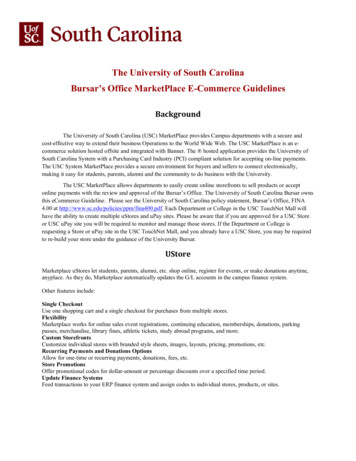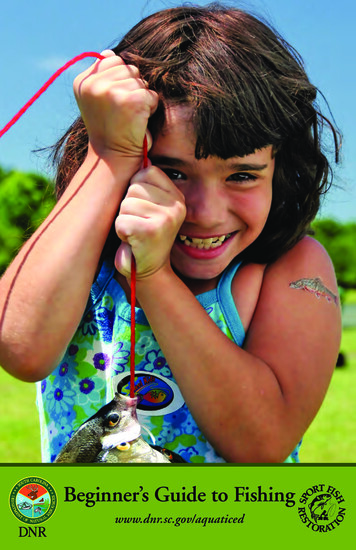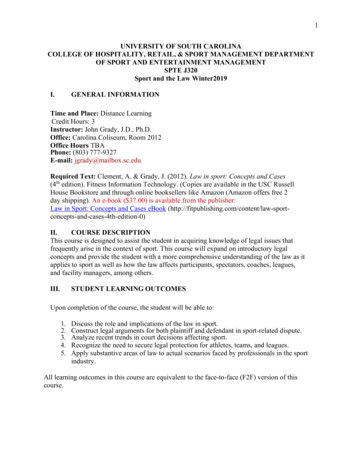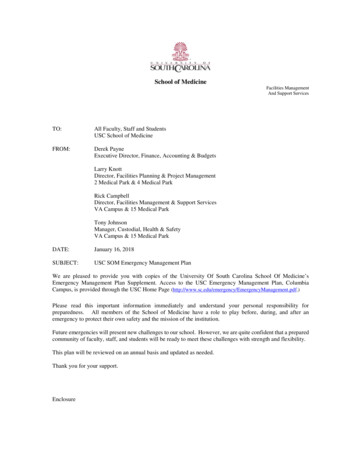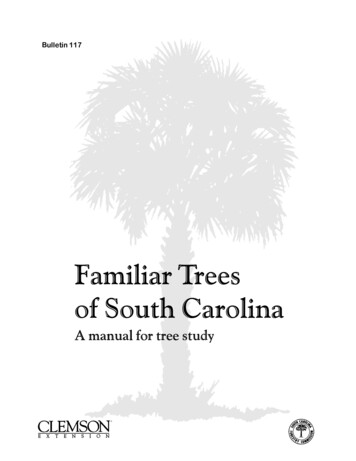
Transcription
Bulletin 117Familiar Treesof South CarolinaA manual for tree study1
CONTENTSPageIllustrations and Descriptions of Trees . 4-18Description of Terms . 19Types of Fruit . 19Key to the More Common Trees of South Carolina . 20-22Acknowledgments . 23Leaf and Twig Characteristics . 24TREEPageAsh, White . 17Baldcypress . 6Basswood, White . 16Beech, American . 15Birch, River . 16Boxelder. 14Catalpa, Southern . 17Cherry, Black . 16Dogwood, Flowering . 12Elm, American . 14Winged . 14Hemlock, Eastern . 6Hickory, Mockernut . 13Pignut . 13Shagbark . 13Holly, American . 12Honeylocust . 17Hornbeam, American . 18Locust, Black . 17Magnolia, Southern . 11Maple, Red . 14Mulberry, Red . 16Oak, Black . 9Blackjack . 10Chestnut . 8Laurel . 10Live . 7Northern Red . 8Overcup . 8Oak, Post . 7TREE . PageScarlet . 9Southern Red . 8Swamp Chestnut . 7Turkey . 9Water . 9White . 7Willow . 10Palmetto, Cabbage . 6Persimmon, Common . 18Pine, Eastern White . 5Loblolly . 4Longleaf . 4Pond . 5Shortleaf . 4Slash . 4Spruce . 5Virginia. 5Redbud, Eastern . 12Redcedar, Eastern . 6Sassafras . 18Sourwood . 18Sugarberry . 15Sweetbay. 11Sweetgum. 10Sycamore, American . 15Tupelo, Black . 11Water . 11Walnut, Black . 13Willow, Black . 15Yellow-poplar . 12The Clemson University Cooperative Extension Service offers its programs to people of all ages,regardless of race, color, sex, religion, national origin, or handicap and is an equal opportunity employer.Clemson University Cooperating with U.S. Department of Agriculture, South Carolina Counties, Extension Service, B. K. Webb, Director, Clemson, S.C.Issued in Furtherance of Cooperative Extension Work in Agriculture and Home Economics, Acts of May 8 and June 30, 19142
Familiar Treesof South CarolinaPrepared by George D. Kessler, Extension Forester and Professor of Forestry, andRoland E. Schoenike, Professor of ForestryTrees, one of the most conspicuous features of the South Carolina landscape, have played an importantrole in the history and the economic development of the Palmetto State.This tree study manual has been prepared to aid 4-H Club members, teachers, youth group leaders,and others who want to identify or to know more about the trees of our state. It is a major revision of abulletin first issued in 1950. A total of 255,000 copies has been printed in the 17 editions issued to date.Nature has endowed South Carolina with a wide variety and abundance of trees. Although this manualdoes not include all the trees found in the state, it is hoped that the 60 more important and commonones covered in this manual will help stimulate observation and arouse interest and appreciation oftrees-one of South Carolina’s most important renewable natural resources.Anyone interested in additional information on trees may consult any of a number of books on treeidentification. Some of these are listed below:Brockman, C. F. and Merrilees, R., Trees of North America, A Field Guide. New York: Golden Press.Elias, T. S., The Complete Trees of North America. New York: Van Nostrand Reinholt Co.Grimm, William C., The Book of Trees. Stackpole Company, P.O. Box 1831, Harrisburg, PA 17105Little, Elbert, The Audubon Society Field Guide for North American Trees. New York: A. A. Knopf.Petrides, G. A., A Field Guide to Trees and Shrubs. Boston, Mass.: Houghton, Mifflin Co.Preston, R. J., North American Trees. Ames, Iowa: Iowa State University Press.3
Loblolly PinePinus taedaLongleaf PinePinus palustrisThis fast-growing pine produces abundant seeds; reseedsabandoned fields. Because of its wide range, abundance, andversatility, loblolly pine is the principal commercial pinespecies in the Southeastern United States.Since the early days of our colonies, longleaf pine has been aprime source of lumber and naval stores (turpentine, tar,pitch, rosin). Has the longest needles of any pine in SouthCarolina — 8 to 20 inches long.Shortleaf PineSlash PinePinus echinataNeedles in clusters of 2's, rarely 3's or 4's. The abundantcones are among the smallest of those of our southern pines— 1½ to 2½ inches long, generally clustered, often remainon the twigs for 3 or 4 years.Pinus elliottiiAlong with longleaf, slash pine yields naval stores. Widelyplanted throughout the Coastal Plain and Sandhills. Thescientific name honors noted S. C. botanist Stephen Elliott,who in 1824 first described it as a variety of loblolly pine.4
Pone PinePinus serotinaVirginia PinePinus virginianaGrows on low, wet flats, usually in lowlands of the CoastalPlain. The short, broad, top-shaped cones persist unopenedon the branches for years.Stiff, gray-green needles 1½ to 3 inches long in bundles of 2,often twisted. Cones with sharp prickles. Old, open conesremain on the branches for several years. Capable of growingon eroded and poorly drained sites.Spruce PineEastern White PinePinus glabraFound on damp coastal sites. Bark and foliage resemblewhite pine. Also known as Walter pine, honoring S. C.botanist Thomas Walter, who published the first descriptionof the tree in 1788 in his Flora Caroliniana.Pinus strobusSoft, flexible, bluish-green needles, only native pine in theEast with 5 needles. The King's Broad Arrow, used to markwhite pine trees reserved as shipmasts for the Royal Navy,helped to stir New England colonists to rebellion.5
BaldcypressTaxodium distichumCabbage PalmettoSabal palmettoFunction of the cypress “knees” is not definitely known.Trees may live for over 1,000 years. Wood is durable. Onlynative southern conifer which sheds its leaves each winter.South Carolina's official state tree, it appears on the stateflag and the state seal and gives the state its nickname of the“Palmetto State.” Blossoms are excellent sources of nectarfrom which bees make honey.Eastern RedcedarEastern HemlockJuniperus virginianaThe reddish, aromatic heartwood is used for making cedarchests and closet linings. Once the principal species used tomake wooden casings for lead pencils. Heartwood durable,used for fenceposts. A favorite Christmas tree.Tsuga canadensisEvergreen thickets of young hemlock provide excellent coverfor wildlife. Can be sheared easily and is sometimes used asa hedge plant. Tolerant of shade and slow in growth.6
White OakQuercus albaPost OakQuercus stellataOne of our largest and most valuable trees. Sometimesattains an age of 600 years or more. High-grade all-purposewood especially suitable for furniture, flooring, and tightcooperage.Variable leaves, cross-shaped in outline. Wood used forcrossties and fence posts. Slow-growing, long-lived. Goodacorn crop every 2 or 3 years. A preferred food of turkey anddeer.Live OakSwamp Chestnut OakQuercus virginianaNow prized as a shade or ornamental tree. In the days ofsailing ships it provided timbers for their construction, andthe U. S. set aside several land preserves of the tree for theexclusive use of the Navy.Quercus michauxiiThe leaves turn a rich crimson color in the fall. Wood usedfor making baskets. Often known as basket oak or cow oak.Long-lived; wood durable.7
Overcup OakQuercus lyrataChestnut OakQuercus prinusThe name of the tree comes from the acorn being almostentirely enclosed in the nearly spherical cup. Often calledswamp white oak or swamp post oak. Nowhere abundant.Grows on poorly drained soils, slow growing, long lived.Heavy, hard, strong, tough, close-grained wood which isdurable in the soil. Large, sweet acorn is a favorite food forsquirrel, deer, and turkey. Acorns mostly too large for smallerbirds.Southern Red OakNorthern Red OakQuercus falcataLeaves are two different types, either pear-shaped with 3rounded lobes or with 3 to 5 irregular-shaped lobes, thecentral lobe usually strap-like and conspicuously long.Quercus rubraA good lumber tree, among the best of the red oaks in quality.Usually found in upper part of state only. Acorns are readilyeaten by squirrels, deer, and turkey.8
Turkey OakQuercus laevisScarlet OakQuercus coccineaLeaves somewhat resemble a turkey's food in shape and areabout 5 inches wide and 5 inches long. Tree is usually notaller than 20 to 30 feet. Most commonly found in sandy,dry soils.Leaves turn brilliant scarlet in autumn, giving this tree itscommon name. Also called Spanish oak as some say its long,narrow, pointed leaves resemble a Spanish dagger. One ofthe fastest growing oaks on poor sites.Black OakWater OakQuercus velutinaLeaves are many shapes, mostly fuzzy on underside withconspicuous brown hairs in the forks of the veins. Bitteracorns are a source of food for many animals. Crowded outof better sites because it can't stand competition.Quercus nigraLeaves quite variable in shape, remain green for some timeand gradually fall during late winter. Rapid grower, easilypropagated. Its spready, symmetrical crown makes it afavorite street and lawn tree.9
Willow OakQuercus phellosLaurel OakQuercus laurifoliaWidely used as an ornamental tree. Slender, willowlikeleaves, smooth bark except for ridges on old trees. Cantolerate more water than most oaks.Often called Darlington oak. Used mainly as an ornamental,planted as a street tree. Leaves remain green on tree untilspring.Blackjack OakSweetgumQuercus marilandicaRarely more than one foot in diameter or more than 40 feethigh with short, stout, often contorted branches forming adense crown. Acorns are food of wild turkey and whitetailed deer.Liquidambar styracifluaCommercially valuable tree. Wood takes a high polish inimitation of more expensive varieties. Widely used forfurniture, cabinet wood, veneer, and pulp. Star-shapedleaves; corky ridges on twigs; ball-like fruit.10
Southern MagnoliaMagnolia grandifloraWater TupeloNyssa aquaticaLarge, leathery evergreen leaves are glossy green on top andrusty-reddish suede on the underside. Large, showy, whitefragrant flowers appear at intervals during the summer. Oneof the most striking and characteristic trees of the deep South.As the name implies, this tree is found in swampy areas. Ithas many of the same characteristics and uses as black tupelo.One characteristic of this tree is the conspicuously swollenbase.Black TupeloSweetbayNyssa sylvaticaOn mature trees bark is deeply and narrowly fissured withoblong blocks resembling alligator leather. Wood is spirallygrained and difficult to split.Magnolia virginianaLeaves are bright, lustrous green above, nearly white beneath.Evergreen; member of the magnolia family with fragrantwhite flowers. Often planted as an ornam
Slash Pine Pinus elliottii Along with longleaf, slash pine yields naval stores. Widely planted throughout the Coastal Plain and Sandhills. The scientific name honors noted S. C. botanist Stephen Elliott, who in 1824 first described it as a variety of loblolly pine.

